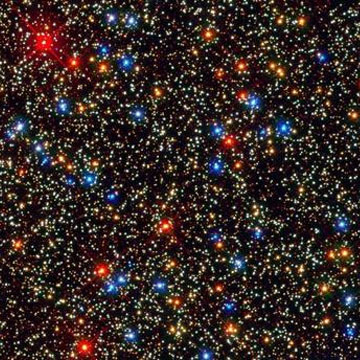 NY:
NY: Contradicting current beliefs, a team of researchers, including one from India, has said that globular star clusters that hold a million stars in a ball only about 100 light-years across on average could also host planets with intelligent life.
For three decades, humans have searched for signs of intelligent life beyond Earth, and yet we've only sampled a tiny drop of our vast cosmic ocean. If we’re ever to find a radio-hot, spacefaring civilization, we need to know where to point our telescopes.
But the answer may be simpler than we thought. According to a new study, there are roughly 150 brilliant patches of space that deserve our attention.
They’re called globular clusters, an evocative term for ancient, gravitationally-bound regions of space that can pack a whopping million stars per hundred cubic light years. Once thought to be uninhabitable, new research by Rosanne Di Stefano of the Smithsonian Astrophysical Observatory and Alak Ray of the Tata Institute in Mumbai suggests that globular clusters may, in fact, be the ideal places for advanced civilizations to flourish.
Di Stefano presented her fascinating idea at the 227th meeting of the American Astronomical Society today.
There are 150-odd globular clusters in our galaxy, most of them located in the galactic halo beyond the Milky Way’s bright center. Despite the extraordinarily high density of stars in these regions, scientists have argued that globular clusters are unlikely to host planets. “Globular clusters are very old, and they formed at a time when heavy element content in the universe was smaller than it is today,” Di Stefano told Gizmodo. “Planets are rich in these heavier elements, and it wasn’t clear if you’d expect to find planets in these low metallicity environments.”
Not only do some astronomers doubt whether globular clusters have the right ingredients to support life, others say the cosmic environment is far too dangerous. When stars are packed tightly, they’re more likely to perturb one another gravitationally. If a wandering star happened whiz past a planetary system, small rocky worlds could literally be kicked into the frigid void of interstellar space. As you can imagine, that’d be a game-over situation for any budding civilizations.
But according to Di Stefano, both of these concerns are overblown. She points out that rocky exoplanets have already been found around around stars with only a tenth the metal content of our Sun. “We now know that Jupiter-like gas giants are metal dependent,” she said. “But today, as a result of Kepler, we also know that small planets orbiting in the habitable zone of low-mass stars aren’t.”
What’s more, the ancient red dwarf stars that populate globular clusters could offer planetary protection. Because red dwarfs are dimmer than the Sun, habitable planets have to hug close to stay warm. According to Di Stefano’s new models, many habitable zone planets in globular clusters are probably shielded from stellar interlopers, due to their tight orbits.
Globular clusters offer two other advantages when it comes to advanced life: time, and real estate. Because these systems are ancient, any civilizations that do emerge could literally have billions of years to evolve. And because stars are so close together, it’d be much easier to hop from one system to the next.
“Traveling at a hundredth the speed of light, it’d take us over 400 years to get to the nearest star,” Di Stefano said. “If that star were 100 times closer, it’d take four years. We’d be in a totally different situation in terms of interstellar communication and travel, if we lived in a globular cluster.”
Of course, we shouldn’t get too carried away imagining all the interstellar get-togethers (or, you know, wars) taking place in these brilliant star systems. A lot more observational data is needed to verify that globular clusters are habitable—to date, we’ve only ID’d a single exoplanet in a globular cluster. (But in all fairness, we haven’t really been looking).
Di Stefano, for her part, is hoping to get more involved with the SETI community and lead new explorations of these intriguing cosmic landscapes. “Globular clusters may be an opportunity,” she said. “Whether anyone is there to take advantage of the opportunity, is not yet clear.”
But we’d be remiss if we didn’t look. After all, 150 is a far less daunting number of targets that a hundred billion.
 NY: Contradicting current beliefs, a team of researchers, including one from India, has said that globular star clusters that hold a million stars in a ball only about 100 light-years across on average could also host planets with intelligent life.
NY: Contradicting current beliefs, a team of researchers, including one from India, has said that globular star clusters that hold a million stars in a ball only about 100 light-years across on average could also host planets with intelligent life.